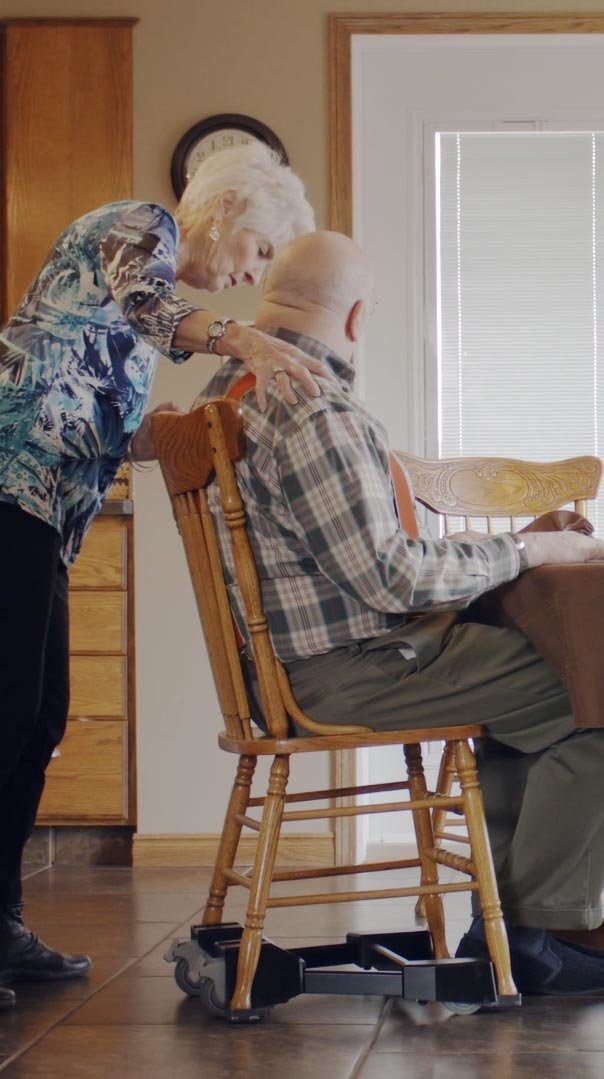Your Cart
Who It Helps
Providing care can be an overwhelming challenge for both family and professional caregivers when caring for a loved one living with reduced mobility due to aging or as a result of any number of medical / health conditions.
-
 Alzheimer’s
Alzheimer’s
-
 Parkinson’s
Parkinson’s
-
 Cerebral Palsy
Cerebral Palsy
-
 Brain Trauma
Brain Trauma
-
 Arthritis
Arthritis
-
 Amputees
Amputees
-
 Multiple Sclerosis
Multiple Sclerosis
-
 Muscular Dystrophy
Muscular Dystrophy
-
 Surgery / Rehab
Surgery / Rehab
-
 Mental Health
Mental Health
-
 Stroke / Heart Issues
Stroke / Heart Issues
-
 Other
Other
Families providing care are encouraged to slow down
their routine, allowing loved ones to control as much of
their movement as they can on their own. Care providers
are remined to employ positive rhythmic techniques to
assist the person and to maintain eye contact with the
loved one while they process your directions.
Care providers are reminded that as a result
of impaired movement, daily tasks will simply take
longer to accomplish.

A. The Challenge at Mealtime
The process of getting a person seated at the table has several distinct challenges which need to be fully understood by the caregiver.
Challenge #1: Getting the person seated safely in a chair
It is not uncommon for a person with limited mobility to bump into furniture while attempting to get seated on a chair. This can have disastrous results as any unintended contact with the chair can cause the chair to move unexpectantly, many times resulting in a fall / injury.
 Office task chair
Office task chair
An office/task chair is deemed unsafe as this style of chair rolls too easily, putting the seated person at risk of falling should the chair move unexpectantly.
 Standard chair
Standard chair
A standard dining chair is deemed unsafe as it does not move easily, putting the care provider at risk on incurring a personal injury!
Challenge #2: Once seated, getting the seated person moved safely up-to the table
The physical demands required of the spouse/care provider to move a seated person up-to the table can be exhausting. Any activity which involves pushing-pulling-shoving-twisting when offering assistance increases the care providers risk of injury/fall.
Challenge #3: Barrier Free Access to the Table (eliminating table interference)
Recognizing the effort required to move a seated person up-to the table, care providers position the chair as close to the table as possible, thereby reducing the amount of physical effort required of them once the person is seated in the chair.

Chairs that turn...roll...and
brake for safety create a barrier free access
as the care provider
moves the chair to the person, instead of moving the person
to the chair. This minimizes the risk of falls as the person requiring
assistance can remain standing supported by their
walker/rollator, nor is the person required to step backwards or
shuffle sideways in an attempt to align themselves with the
chair.
The risk of injury to the care provider is
also minimized as the person once seated can be moved up-to the
table with ease and grace.
B. A Safe Innovative Solution: The Chair Caddie...

 Enables a caregiver to move a seated
person up-to the table safely, with ease and grace.
Enables a caregiver to move a seated
person up-to the table safely, with ease and grace.
 Attaches to the base of a person’s
favorite kitchen / dining chair. When attached the
caregiver
rolls the chair to the person being seated,
eliminating the need for the person to step backwards /
shuffle sideways when aligning themselves with the
chair.
Attaches to the base of a person’s
favorite kitchen / dining chair. When attached the
caregiver
rolls the chair to the person being seated,
eliminating the need for the person to step backwards /
shuffle sideways when aligning themselves with the
chair.
 Prevents mealtime falls as the person
is seated with confidence
Prevents mealtime falls as the person
is seated with confidence
 Eliminates the need for the caregiver
to exert physical effort (push-pull-shove-twist) when
moving a seated person up-to the table
Eliminates the need for the caregiver
to exert physical effort (push-pull-shove-twist) when
moving a seated person up-to the table
 Eliminates interference caused by the
chair being placed too close to the table.
Eliminates interference caused by the
chair being placed too close to the table.
 Reduces the risk of the caregiver
being injured (Spouses are also seniors and often not
able to provide assistance)
Reduces the risk of the caregiver
being injured (Spouses are also seniors and often not
able to provide assistance)
 Creates a safer and more enjoyable
mealtime routine as stress and anxiety are reduced for
both the seated person and the caregiver
Creates a safer and more enjoyable
mealtime routine as stress and anxiety are reduced for
both the seated person and the caregiver
 Increases the seated person’s sense of self-worth and
dignity!
Increases the seated person’s sense of self-worth and
dignity!